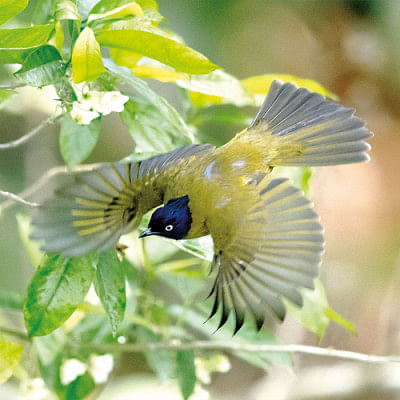Taking Flight

A bird taking flight is an exquisite and miraculous event. Raising its wings, it spreads them while kicking off with its feet to sail through the air. The swift and energetic display has visual drama. Capturing it on camera is a challenge for the photographer, mainly because one cannot predict the precise moment of takeoff.
Many birds are so fast that the human eye cannot resolve all the different movements working together to attain flight. Other birds are slower to lift off and we can see the motions they go through before attaining fight.
For example, consider the largest bird of Bangladesh. The Lesser Adjutant, a long-legged stork, stands at over three feet tall and weighs around ten pounds. For food it forages from soft ground such as river banks and paddy fields. It needs a long runway when it takes off because it runs while flapping its wings until it reaches takeoff speed. The photographer has enough time to catch the action.
A Pallas's Fish Eagle, also a large bird, often takes off from tall branches. It flaps its large wings across a wide arc several times as it is taking off. While it takes off faster than a Lesser Adjutant, it is still slow enough to capture if your camera is focused on it.
On the other hand, small and medium birds such as Sparrows, Doves or Parrots take off like a bullet. It is extremely difficult to capture this on camera: a photographer must make numerous attempts before a satisfactory photograph is captured.
Several water birds, such as the Coot or the Purple Swamphen, run on the water before taking off, leaving a series of concentric ripples in their wake. They are easier to catch on camera if you are prepared. Ducks are another matter. They take off very fast. But a flock resting on water will take off somewhat sequentially, creating an opportunity for the alert photographer.
When I find a bird resting long enough for me to focus my camera on it, I immediately take a picture. Then I wait for it to take off so I can have an "action shot". It never notifies me, but sometimes drops indirect hints. For example, if it defecates, chances are it will fly soon. Sometimes, after preening its feathers, it will wait for a few seconds before flying. Before flight, larger birds sometimes crouch. But I miss the vast majority of my attempts because in the split second of takeoff, my finger on the shutter is too slow.
There are several points of photographic aesthetics that come into play. For example, if it flies away from you, the photograph is not interesting. Usually birds fly into the wind in order to get lift, paying attention to wind direction is helpful. If you can photograph from above the bird – for example, from a tower or a rooftop – you can capture nice wing patterns.
The basic science of flight is the same for all birds. With their strong muscles they flap their wings which propel them forward, getting the air over and under their wings moving. This creates an upward force, lift, which enables them to fly. Yet each bird species has its own signature style of taking off. Photographing this action has been a challenge, but if I get a good shot it makes the effort worthwhile.
facebook.com/ikabirphotographs or follow ihtishamkabir on Instagram.

 For all latest news, follow The Daily Star's Google News channel.
For all latest news, follow The Daily Star's Google News channel. 




Comments